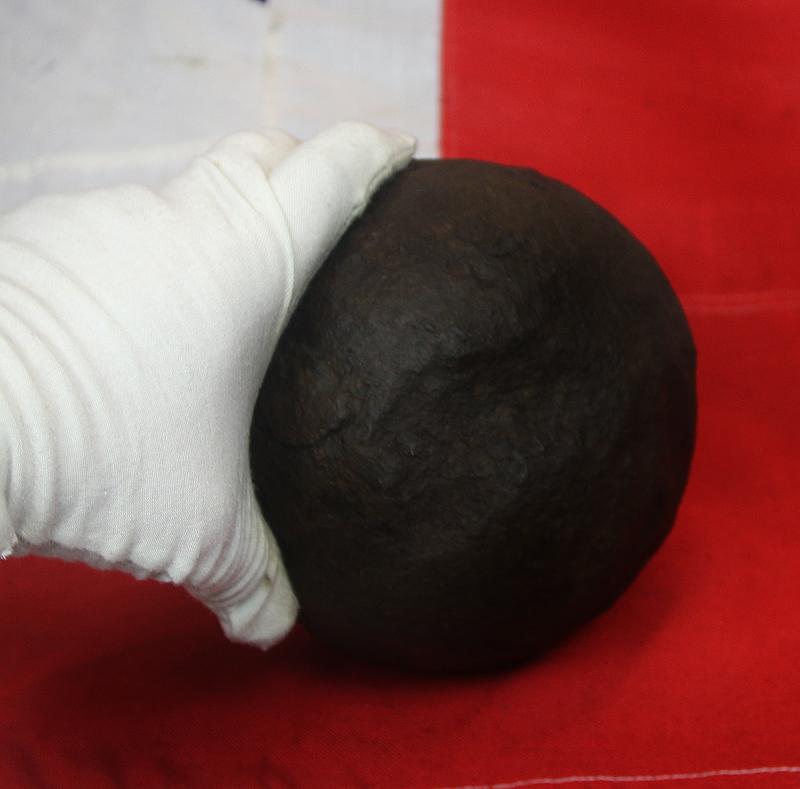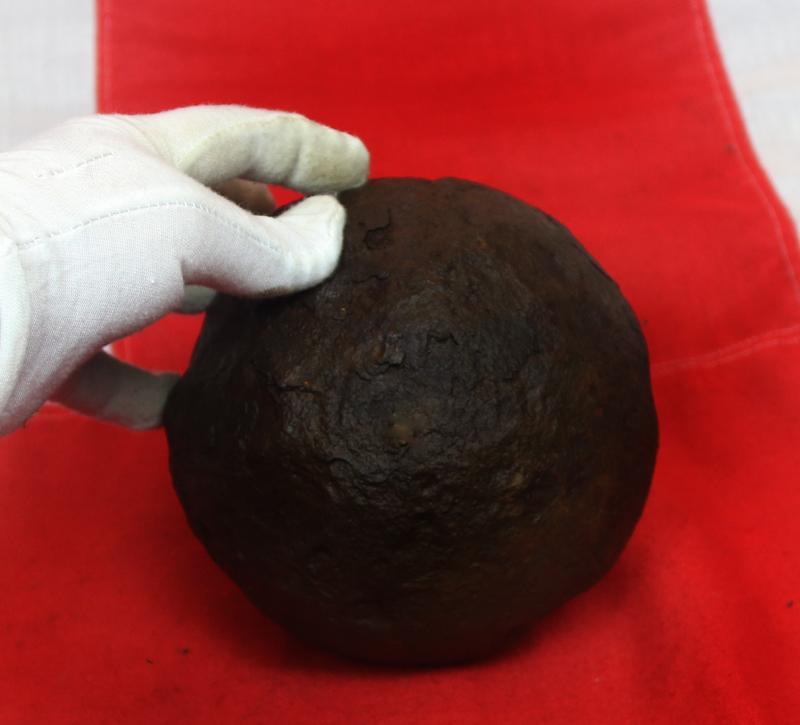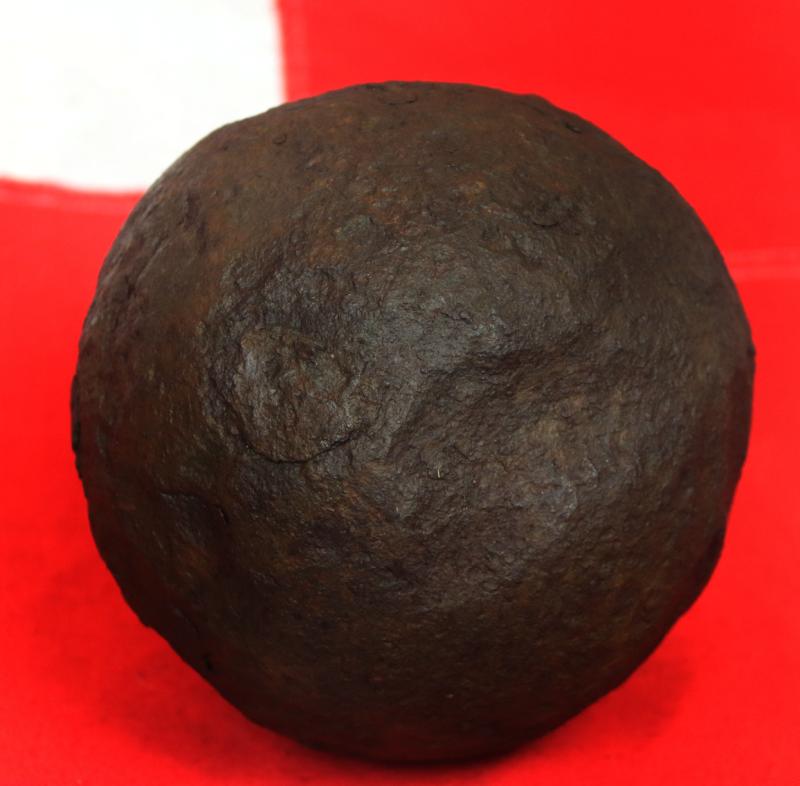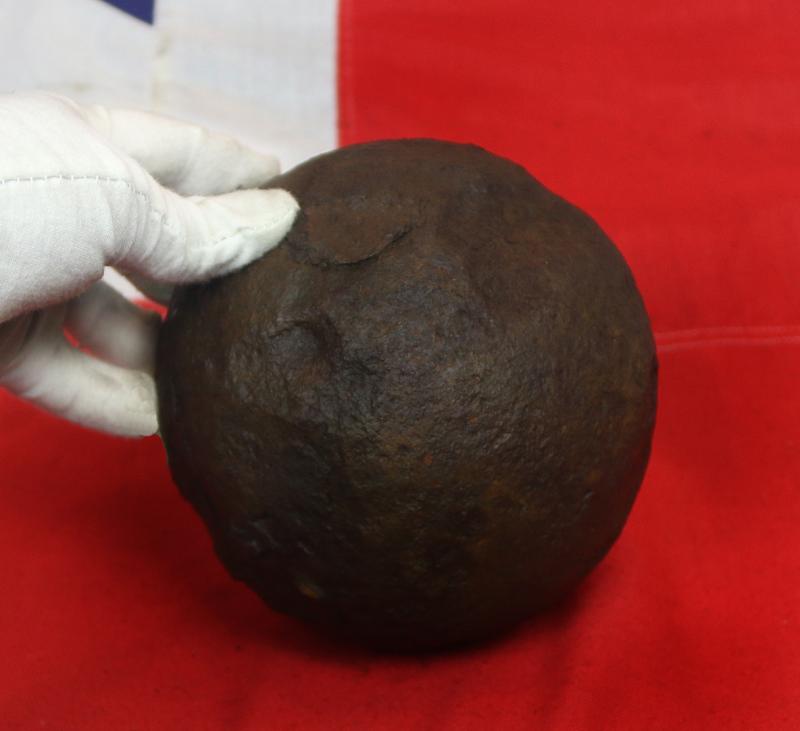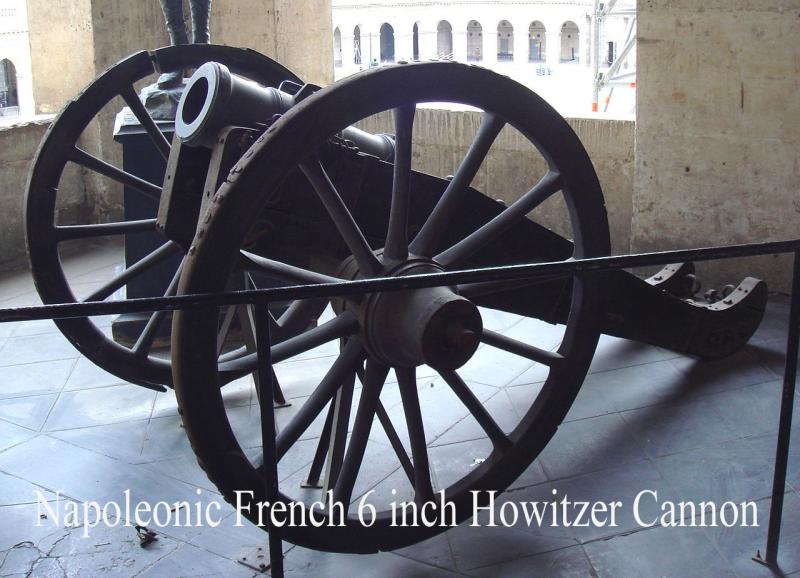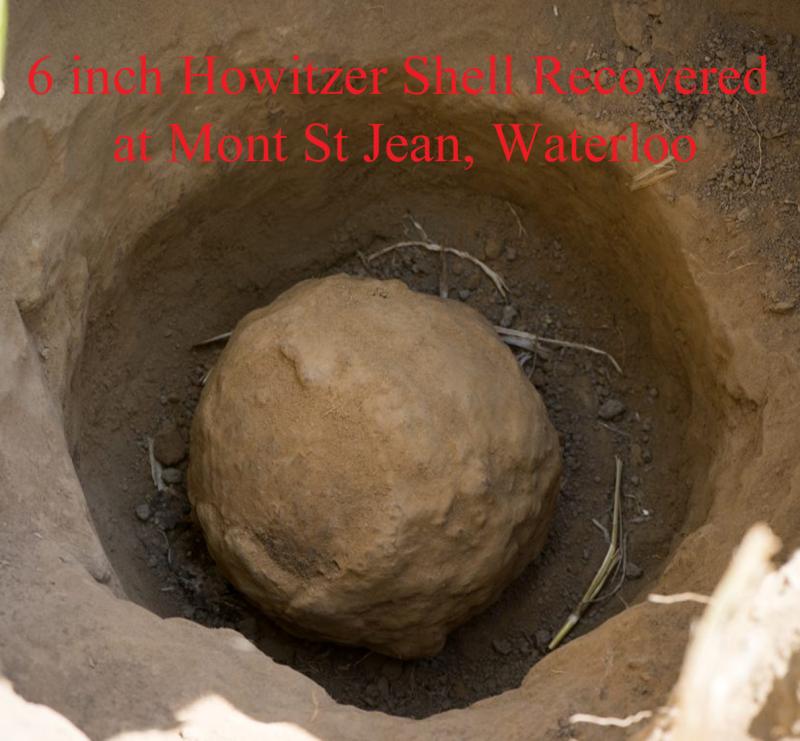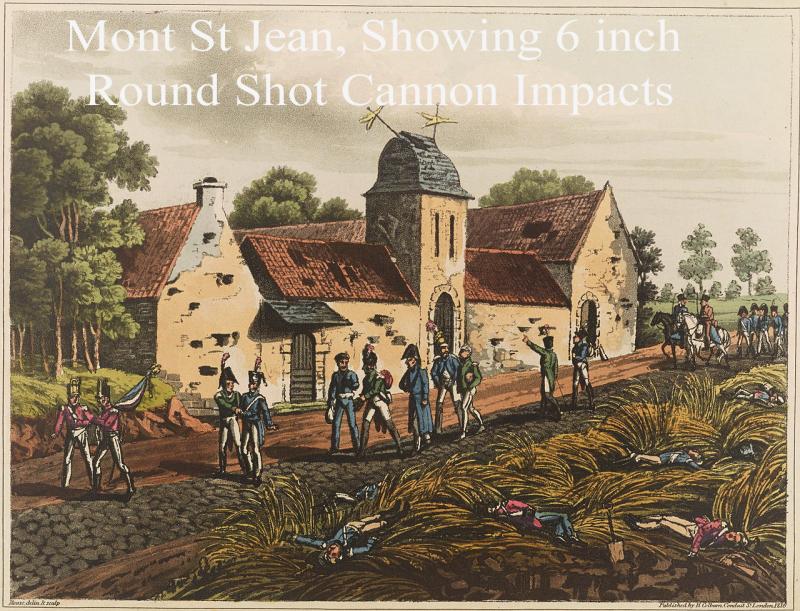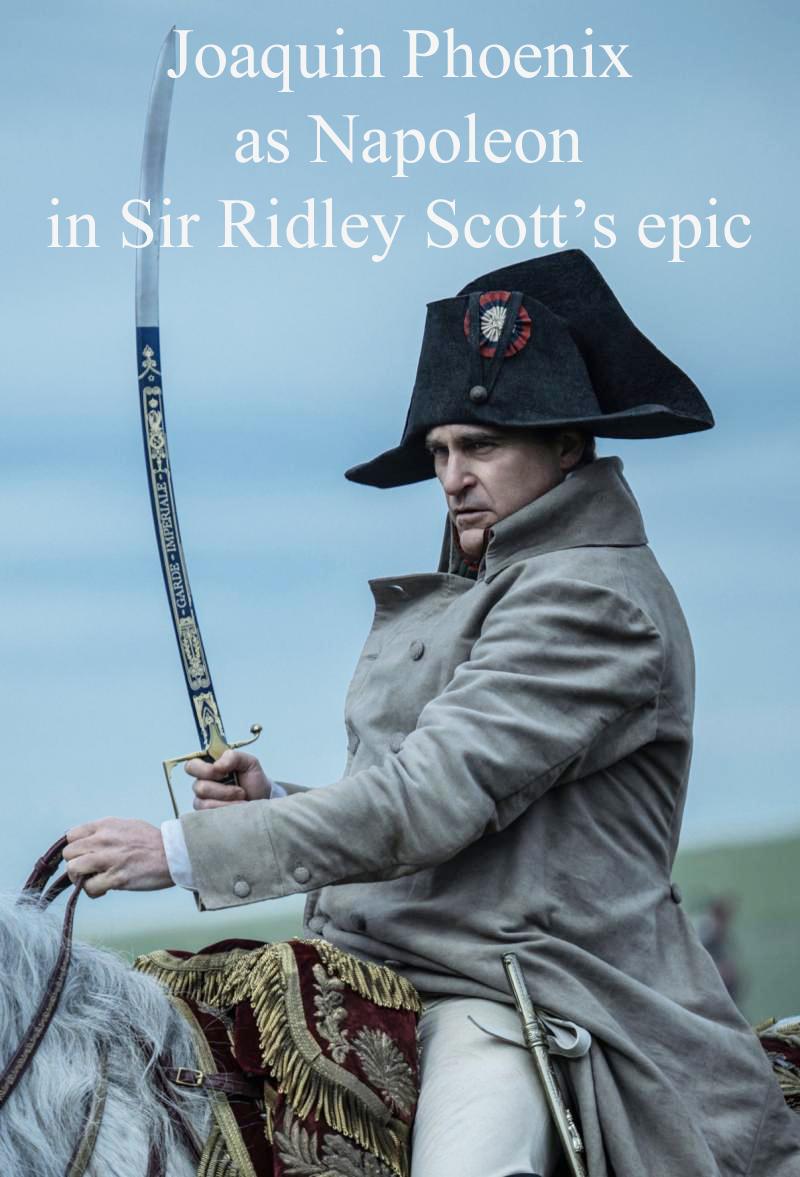A Very Rare French Battle of Waterloo Excavated 6 inch Howitzer Solid Round Shot Iron Cannon Ball. Recovered From Waterloo Battle Site and Weighing Around 28 Pounds
Very rare piece indeed, in that the Howitzer were sparsely used at Waterloo, due to there size, with 6 regular cannon, used in support, by the French artillery, for every two Howitzers used, and each Howitzer was operated with a 13 man crew. And of course, more than half of all the Howitzer six inch rounds were explosive, and thus detonated, leaving no residual cannonball to recover. This is a recovered non-explosive version recovered at either La Haye Sainte or Mont St Jean
What an amazing, large and impressive historical centrepiece for any collector or collection. We bought a very small collection of very rare 6" Howitzer cannon balls recovered during a Grand Tour of the battle site in around 1820 when the Prince of orange mound was being built. Two explosive and two solid round shot 6" Howitzer balls, Imagine the family gatherings or dinner parties that would be enlivened by such an incredible historical artefact and conversation piece! To speculate the incredible hours of battle, with hand to hand combat and the frantic melee that this cannonball was involved within, fired by a French Howitzer crew at the heroic British infantry, or our valiant Prussian volunteer allies of the Kings German Legion, during the glorious defence of La Haye Saint, or the British Guards regiments defenders of Hougemont
The artillery of the French army was almost completely redesigned by Jean Baptiste Grimbeauval from 1765 onwards, standardising gun calibres and making gun carriages lighter and easier to transport, allowing for more flexible and efficient manoeuvring. A typical French artillery battery during the Napoleonic Wars was made up of four to six cannons with the support of two 6-inch howitzers. The shell we discovered would have had a maximum range of around 1100m and would have been most deadly at a range of 640m
Our shell would have been shot from a 6-inch howitzer, that fired, either hollow cast or solid round shot cannonballs. Around 24lb in iron weight for a hollow cast exploding mortar, and around 30lb in weight for round shot. It was the largest of the 3 sizes of howitzer used by the French during the Battle of Waterloo, which would have required 4 horses to draw it and 13 crewmen to fire it – an efficient team would have been able to fire one round ever minute.
A cannonball is a solid ball of metal, known as round shot, which could smash through the ranks of soldiers, causing massive devastation. In contrast, an explosive mortar howitzer shell is a hollow iron sphere filled with gunpowder, with a slow burning fuse fitted to the case. Once lit, it was intended to explode above the heads or at the feet of the Allied soldiers, causing enormous amounts of damage to their formations. A howitzer throws it shells high into the air with a sharp trajectory, and is designed to bring ‘indirect fire’ down on enemy formations either in buildings as at Hougoumont, or, as here, behind a ridge and out of direct sight. While the shell discovered at Mont Jean is known as a 6-inch howitzer shell, an Old French inch is actually equivalent to 1.066 modern inches, so the dug up shell was in fact 6.4 inches in diameter but with size losses due to surface erosion.
We show in the gallery the 6 inch French Howitzer cannon ball recently recovered at Mont St Jean at Waterloo, that when fired, impacted deep underground, and was latterly recovered from the dig. the engraving photographed in our gallery shows the farm house of Mont St. Jean. This house being close to the rear of the action, it was much dilapidated by random shot (1815). Engraver James Rouse. Note the round shot impacts through its walls.
Better photos to be added, currently photos are shown of the past sold Howitzer
In our opinion this is a "never possible to better" original, WW2 sword, used and carried by of an officer of the divine Emperor Hirohito's Imperial Navy in WW2. Ideal for the collector of the very best surviving officer's swords of WW2.1937 pattern Kai Gunto, by Yoshitsugu. With all it's original and gilded mounts and fittings, with near mint black lacquer saya under brown leather protective cover. With it's original naval knot in mint order, and original cord loop with sliding mount. Original naval style flattened knot ito wrap over darkened black same. Every part of this sword's fittings are original and matching, with it's original number 757 stamped onto every separate part. The blade is absolutely near perfect and near flawless, with only one very small stain, with all it's original finish, and fully signed tang. This sword would, effectively, be impossible to upgrade if you wanted the best possible available, regulation, deluxe grade tachi sword, as commissioned by a Japanese naval officer in WW2, in absolutely untouched original condition. Effectively, it is just like the day it was surrendered in 1945. The illustrative photo shows three Imperial Japanese Naval flying officers the central figure carrying the same sword. Crewmen of Ginga bomber that hit aircraft carrier Randolph (from left to right): Chief Flight Petty Officer Takeshi Igai (navigator), Lieutenant Koetsu Fukuda (pilot), and Chief Flight Petty Officer Kenji Ota (radioman)
Kaigunto swords are now getting to be quite difficult to find, and of course were in far less profusion at the surrender in 1945, due to the relatively small amount of Japanese warships that survived the war.
Imperial Japanese Navy in World War II.
The IJN launched a surprise attack on Pearl Harbor, killing 2,403 Americans and crippling the US Pacific Fleet. During the first six months of the Pacific War, the IJN enjoyed spectacular success inflicting heavy defeats on Allied forces. Allied navies were devastated during the Japanese conquest of Southeast Asia. Japanese naval aircraft were also responsible for the sinkings of HMS Prince of Wales and HMS Repulse which was the first time that capital ships were sunk by aerial attack while underway. In April 1942, the Indian Ocean raid drove the Royal Navy from South East Asia.
In 1943, the Japanese also turned their attention to the defensive perimeters of their previous conquests. Forces on Japanese held islands in Micronesia were to absorb and wear down an expected American counteroffensive. However, American industrial power become apparent and the military forces that faced the Japanese in 1943 were overwhelming in firepower and equipment. From the end of 1943 to 1944 Japan's defensive perimeter failed to hold.
The defeat at the Philippine Sea was a disaster for Japanese naval air power with American pilots terming the slanted air/sea battle the Great Marianas Turkey Shoot, mostly going in the favour of the US,126 while the battle of Leyte Gulf led to the destruction of a large part of the surface fleet. During the last phase of the war, the Imperial Japanese Navy resorted to a series of desperate measures, including a variety of Special Attack Units which were popularly called kamikaze. By May 1945, most of the Imperial Japanese Navy had been sunk and the remnants had taken refuge in Japan's harbours. By July 1945, Nagato was the only remaining ship of the Imperial Japanese Navy's capital ships that had not been sunk in raids by the United States Navy
Every single item from The Lanes Armoury is accompanied by our unique Certificate of Authenticity. Part of our continued dedication to maintain the standards forged by us over the past 100 years of our family’s trading, as Britain’s oldest established, and favourite, armoury and gallery
Code: 25422
745.00 GBP


